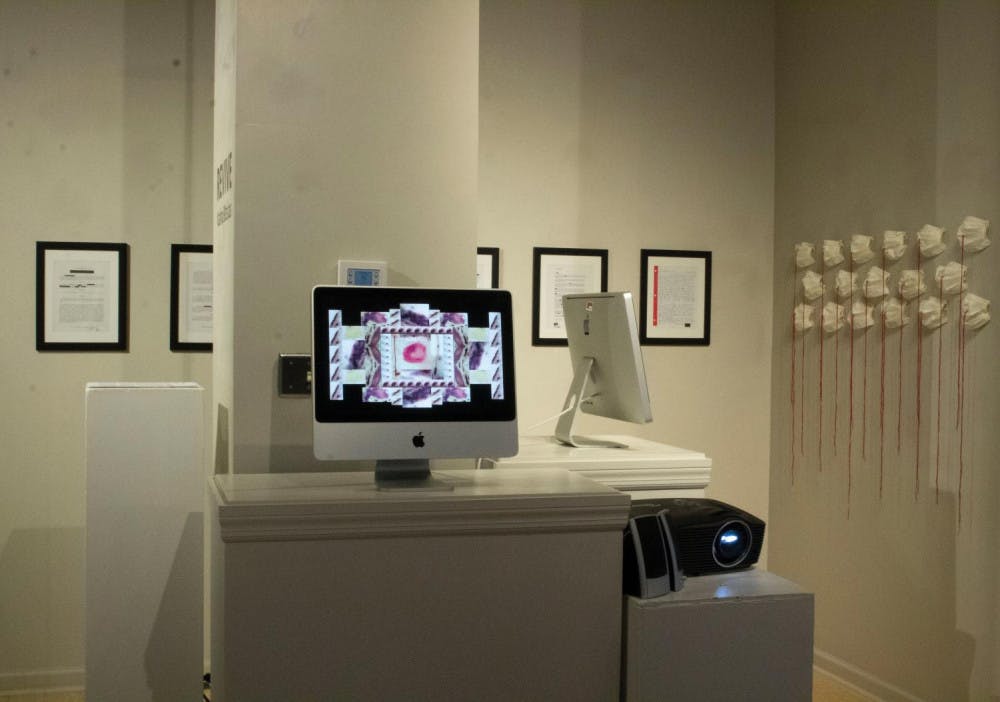Katina Bitsicas is the current visiting artist at Plunkett Gallery. Bitsicas’ exhibit, entitled “Revive,” explores themes centered around coming back to life even with death edging close. She uses the motif of red thread, commonly associated with human connection, to symbolize loss and longing in her multimedia exhibit.
Bitsicas is a new media artist, a genre that utilizes modern technologies to create artwork. She personally specializes in photography, performance and video, and her artwork has been shown around the world. Currently, Bitsicas is the University of Missouri’s Program Director and Assistant Professor of Digital Storytelling.
Her pieces commonly ponder the effects of trauma, often relating her personal experiences in order to bring widespread societal issues to an intensely human level.
“Revive” is unique in that it not only contains Bitsicas’ traumatic experiences with hospitals due to her father’s struggle with Stage Four Mantle Cell Lymphoma, but relates it to Luci Cook’s transplant-related post-traumatic stress disorder after receiving three heart transplants. Through conveying their shared experiences in art, Bitsicas visually demonstrates the innate need for connection among people.
Her exhibit also clearly illustrates the loneliness and loss felt by people in hospitals.
“Conversation about the trauma and PTSD involved with transplants is seen as taboo,” Bitsicas wrote in her artist’s statement.
Bitsicas’ artwork fights against this taboo to open up a conversation about the trauma of medical issues and procedures. The gallery is almost overwhelmed with grief. In one corner, a series of cloth panels traces a line from Bitsicas’ house to her father’s, a journey she was unable to take when he was diagnosed with cancer. On one wall hangs a triple sequence of embroideries, each uniquely related to Bitsicas’ father’s journey with cancer and on another, several bleak hospital masks hang and spit out red threads.
However, Bitsicas’ pieces also speak to hope. In a previous performance involving the emotionless hospital masks, Cook removed their masks and kissed them on the forehead, “reclaiming the traumatizing medical experiences as well as forming a personal connection” with the physicians who treated but rarely spoke to her.
Three videos are projected onto one of the gallery’s walls, representing the three different hearts Cook has received, and feature Cook beautifully describing the location and feel of each. The third embroidered piece in the aforementioned sequence represents Bitsicas’ coping mechanism.
“Revive” demonstrates Bitsicas’ adeptness in weaving together form and content and trauma and recovery. Her exhibit is breathtaking and forces viewers to consider more deeply their connection to others, particularly to those who have experienced trauma.
Bitsicas’ exhibit will be available to visit at Plunkett Gallery in Hardeman Hall until Oct. 31.
Ivy Marie Clarke ‘22 is an English literature and creative writing double major, double minoring in art and women’s and gender studies. She has served as editor of the Arts & Culture section of The Cluster for the last two years. She also interns with Macon Magazine and Mercer University Press and edits for The Dulcimer. She also enjoys drinking coffee and writing poetry.




